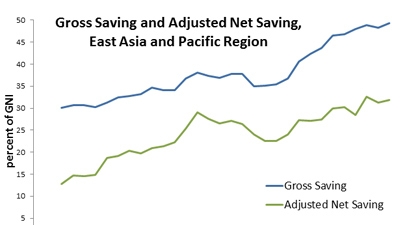Releasing the Little Green Data Book 2013 on World Environment Day, Juergen Voegele, World Bank Director for Agriculture and Environmental Services, said an indicator like ANS is critical to the ongoing post-2015 development dialogue.
"As the global community decides on goals related to water, energy access or food, better information on the state of natural resources becomes vital. Success on these goals is underpinned by the health of natural resources and environment. Conventional indicators like GDP do not have this information," said Voegele.
Ability to inform the post-2015 development agenda
The process for Sustainable Development Goals (SDGs) was launched when leaders from around the world gathered in Rio de Janeiro in June 2012 for the United Nations Conference on Sustainable Development (Rio +20). These goals are expected to define the post-2015 agenda, building on the Millennium Development Goals. Issues currently being discussed for SDGs cover the three pillars of sustainability — economic, social, and environmental.
Yet, many countries do not have the information they need on the state of their environment and natural resources — whether in terms of GDP or from other conventional indicators. Increasingly, they need a new generation of metrics to monitor sustainable development at the macroeconomic level. Following Rio+20, the first report of the High-Level Panel of Eminent Persons on the Post-2015 Agenda (chaired by the presidents of Indonesia and Liberia and the prime minister of the United Kingdom) released last week, identifies the need for better indicators to measure progress on goals as well as better data on natural capital.
Adjusted net savings (ANS) could be one such indicator providing a new lens on growth and development. "The ANS is a policy-sensitive indicator that provides an early warning signal to policy makers about the sustainability of their country’s economic growth path, allowing them to make corrections as needed," said Glenn-Marie Lange, World Bank program manager for Wealth Accounting and Valuation of Ecosystem Services (WAVES).
Growing demand for green growth that can be measured
In the past, ANS was used in some countries, like Ghana, Ecuador, Egypt, and Indonesia, to show the value of natural resource assets and assess the cost of degradation and the consequent loss to GDP. This helped strengthen the World Bank’s dialogue with countries about economic growth and sustainable development strategies.
Increasingly, countries want and need greener and more inclusive growth, as well as better ways to measure it. Several countries are working with WAVES, a World Bank-led global partnership, to include the value of natural capital in their national accounts and economic decision making.
In April 2013, more than 35 finance, development and planning ministers came together at a High-Level Ministerial Dialogue in Washington, D.C., to find out how they can better construct natural capital accounts to help answer their key policy challenges.
In addition to ANS, the Little Green Data Book has data on other key sectors such as agriculture, forests and biodiversity, energy and emissions, water and sanitation, environment and health and oceans.



